THE THEORY OF PHONETICS Lectures 1+2 By Elena

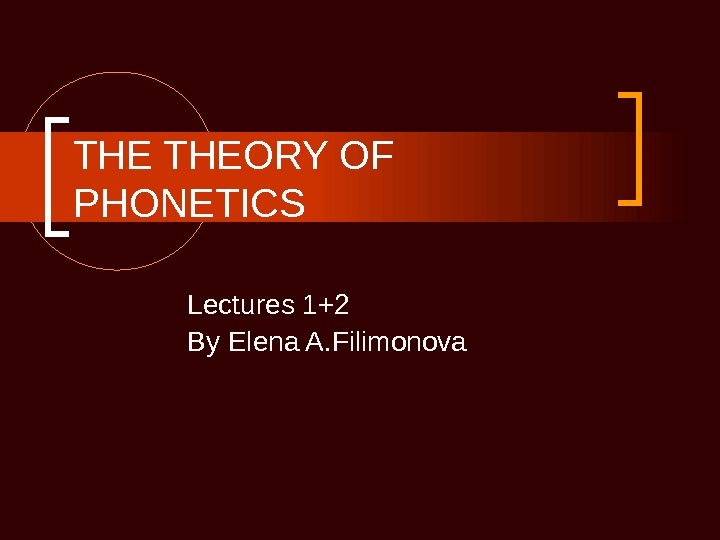
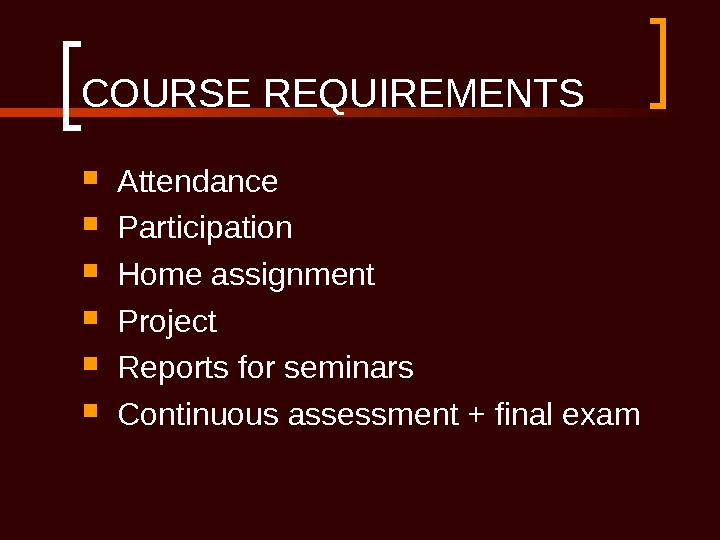

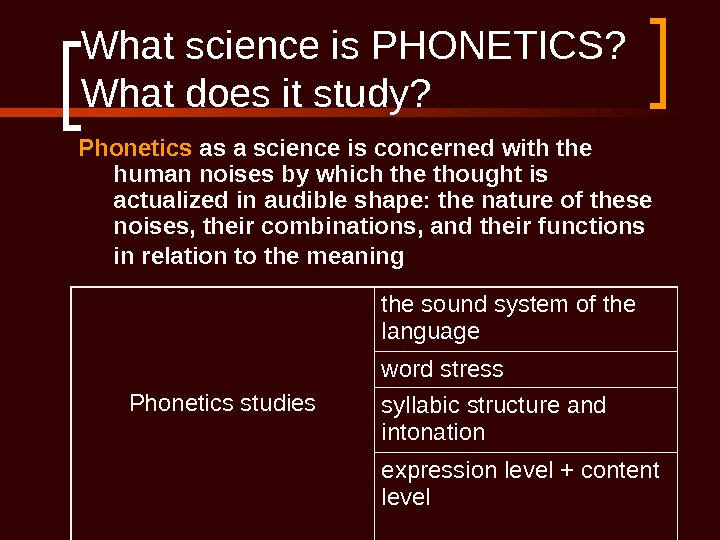
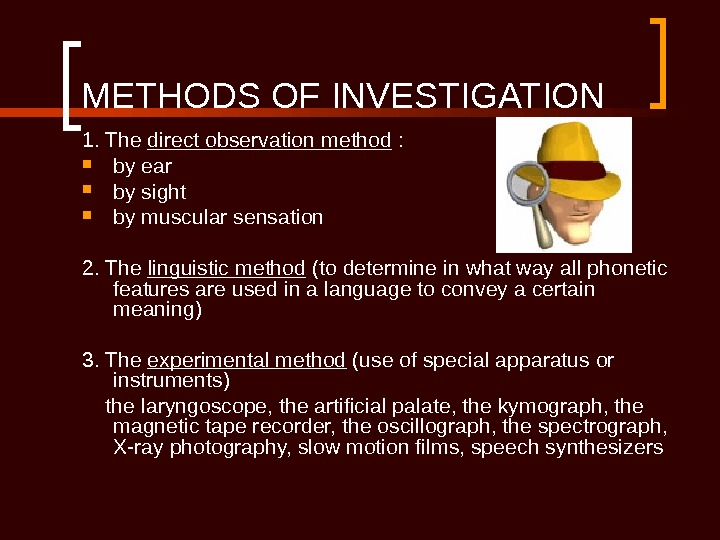
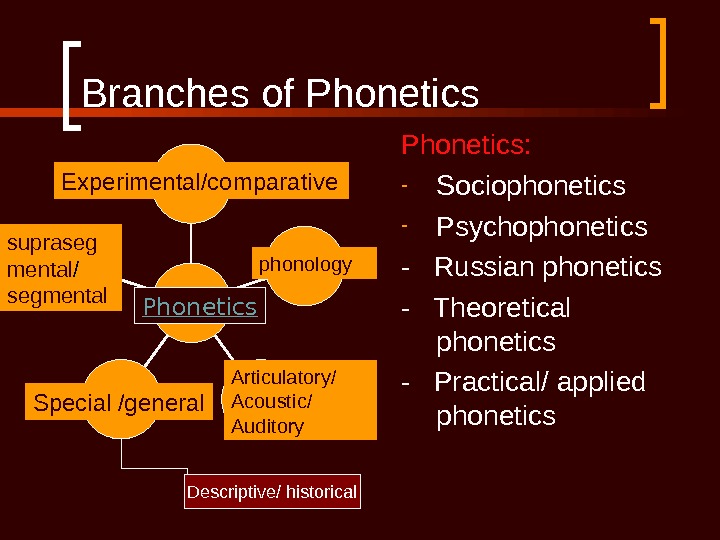
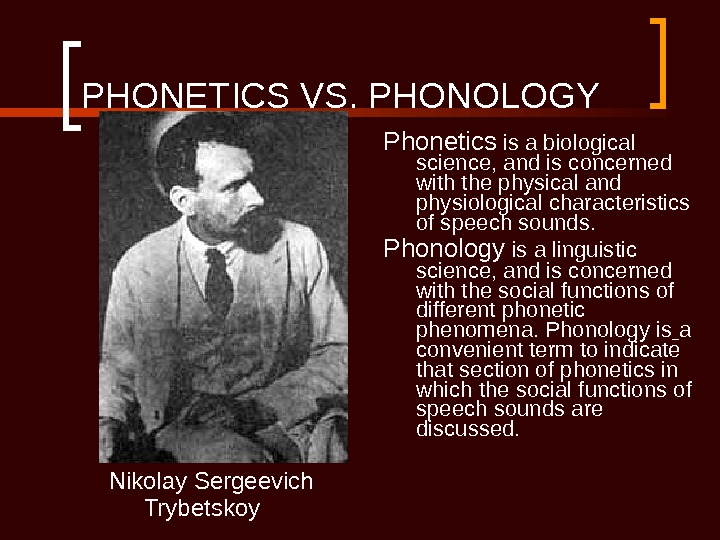
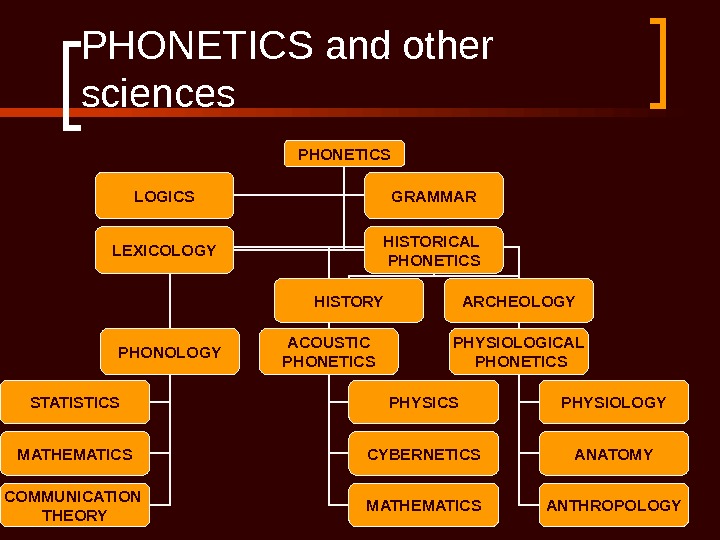
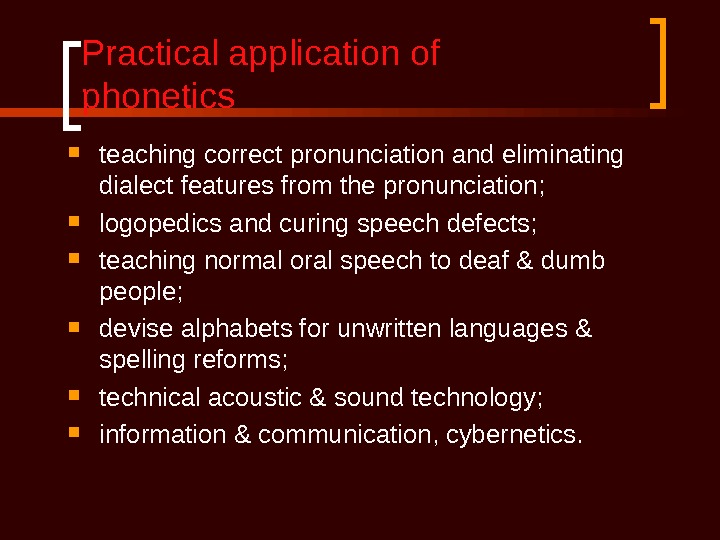
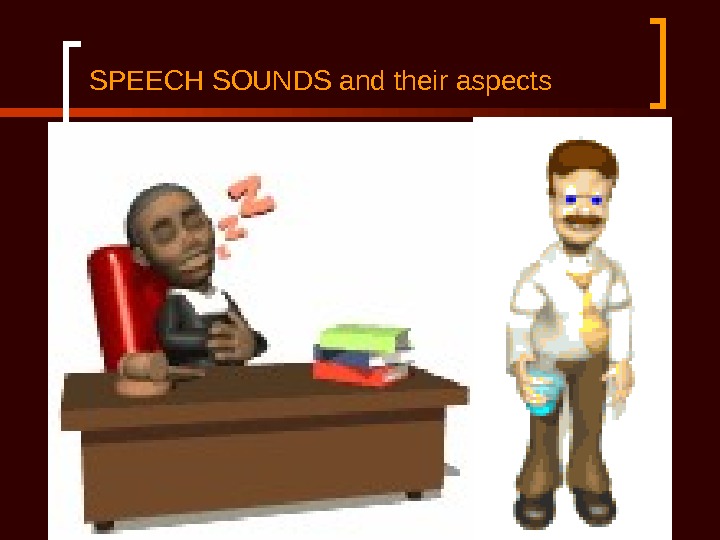
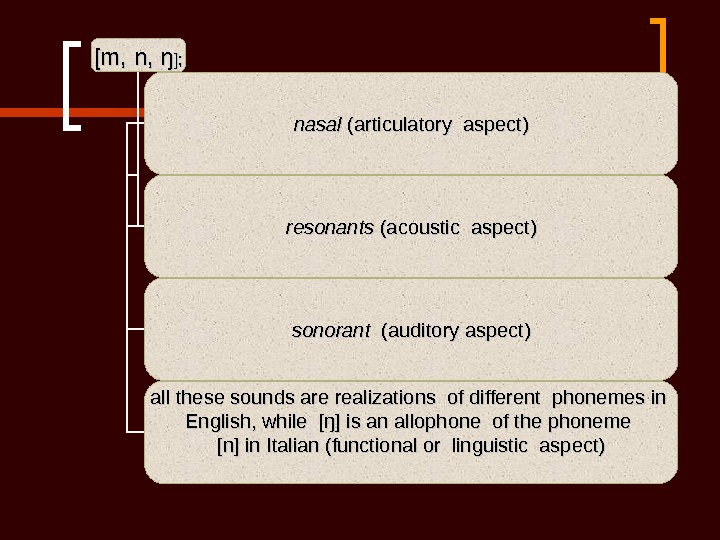
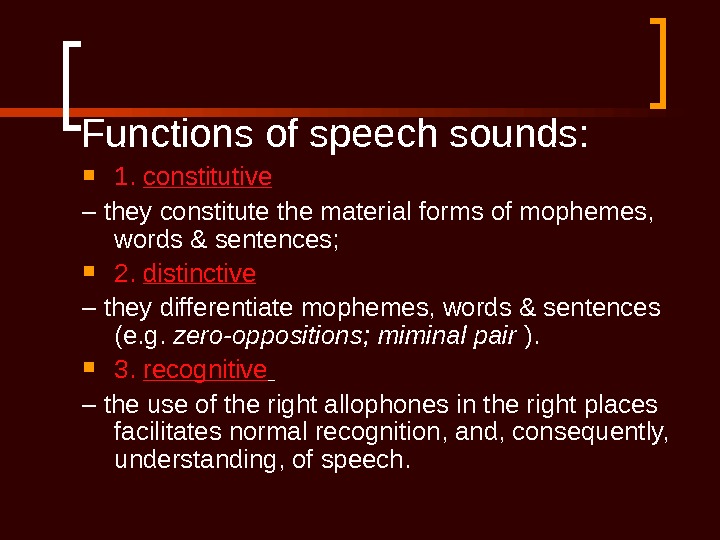


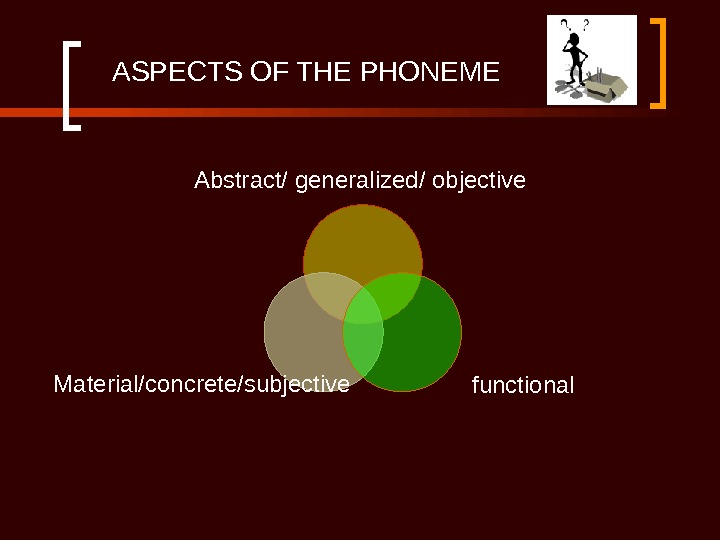
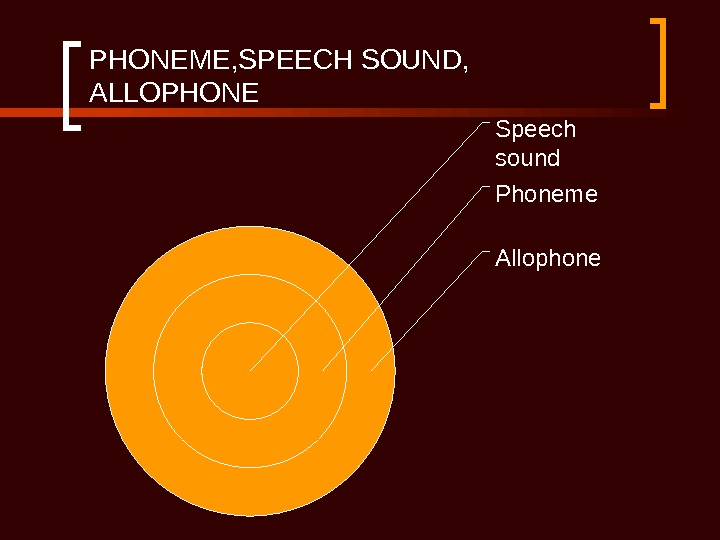
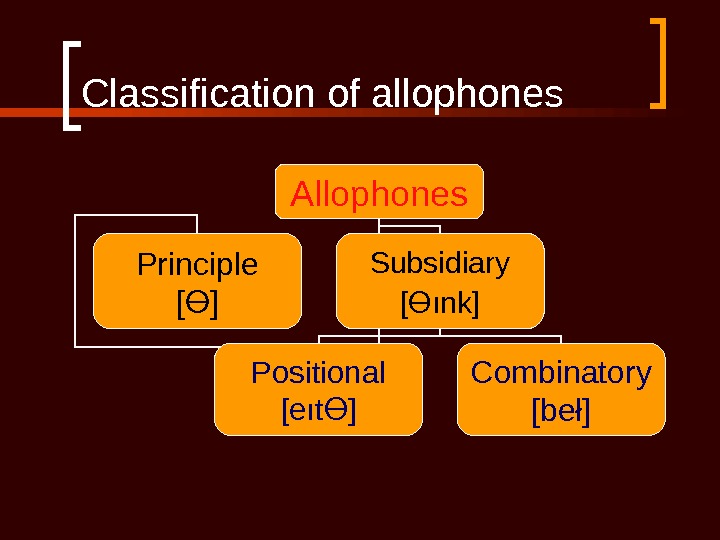
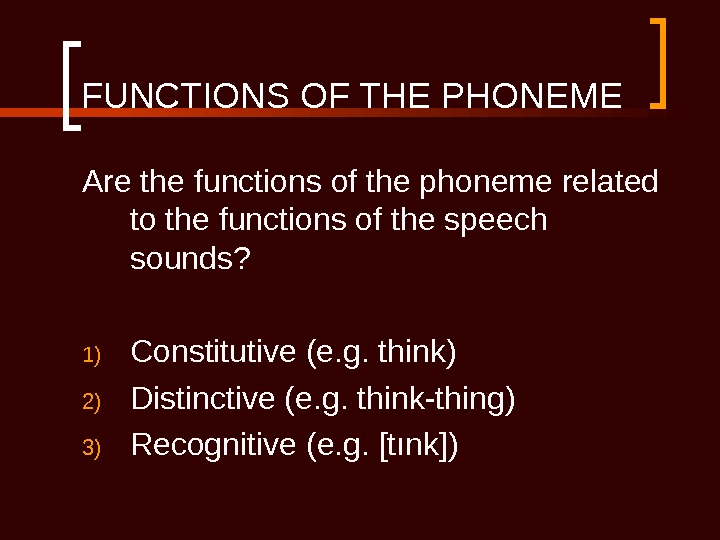
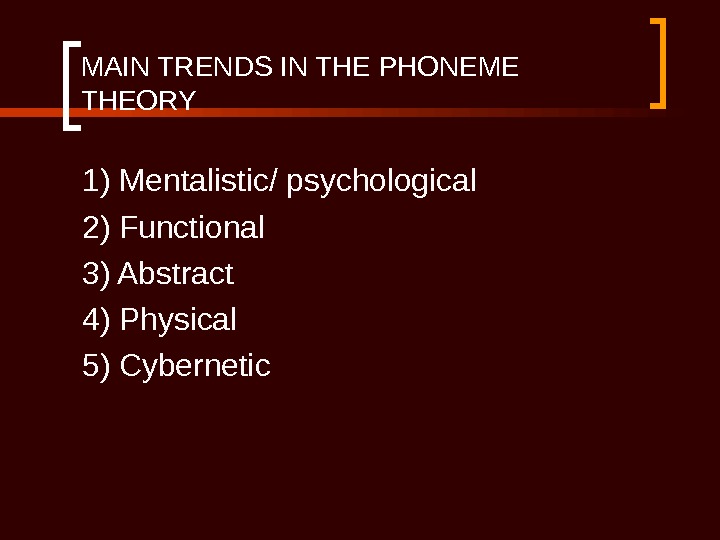
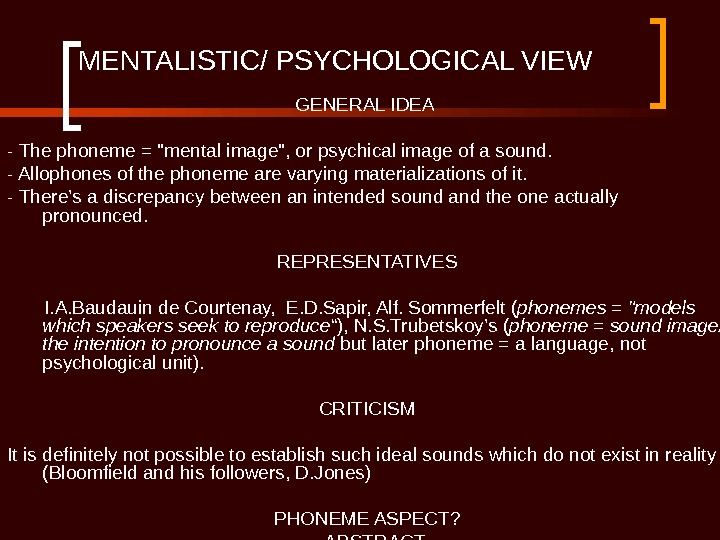
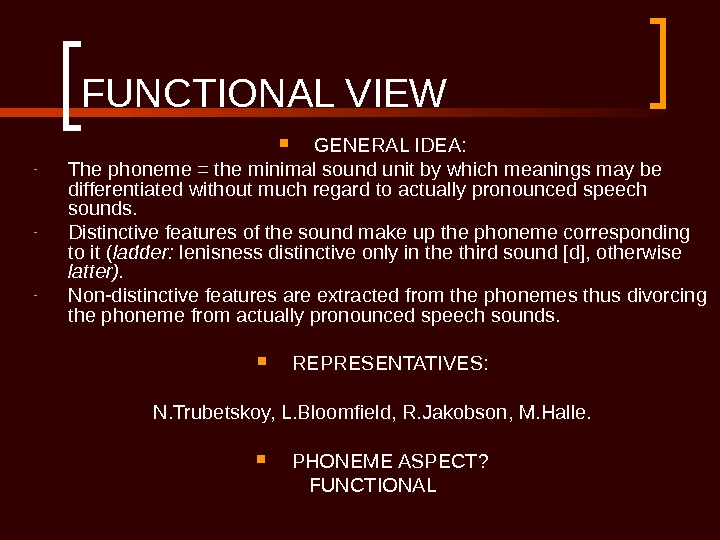
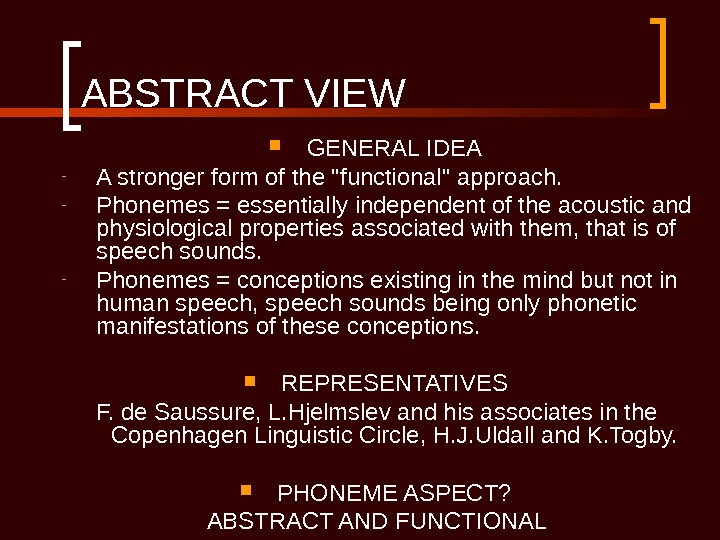
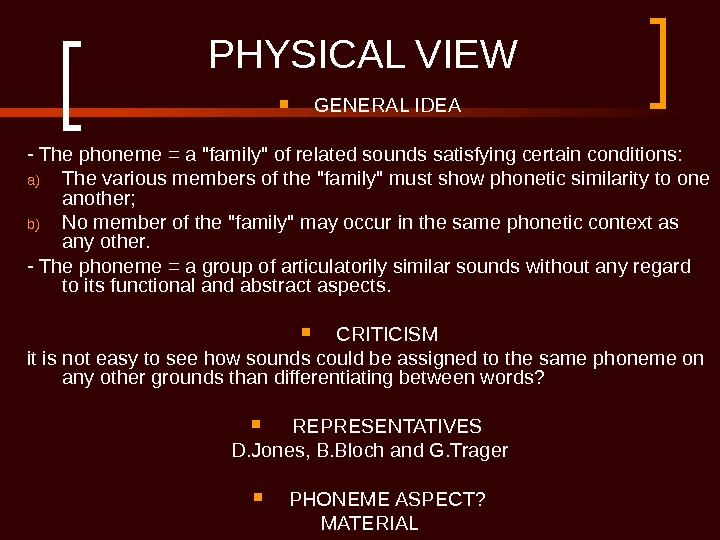
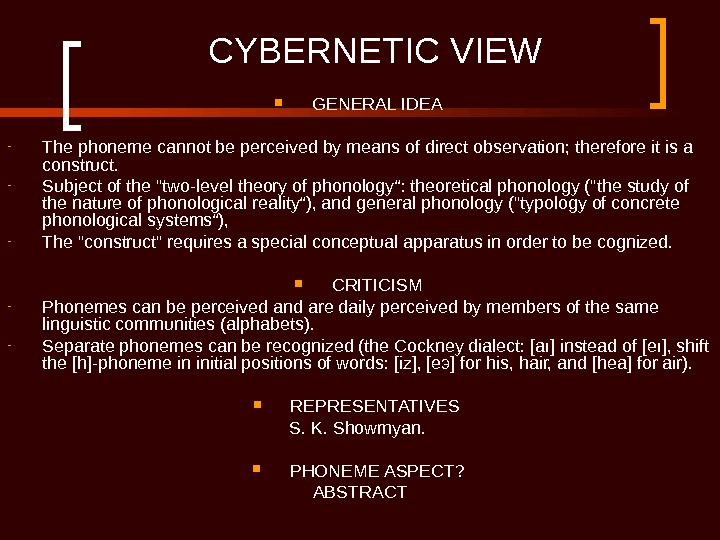
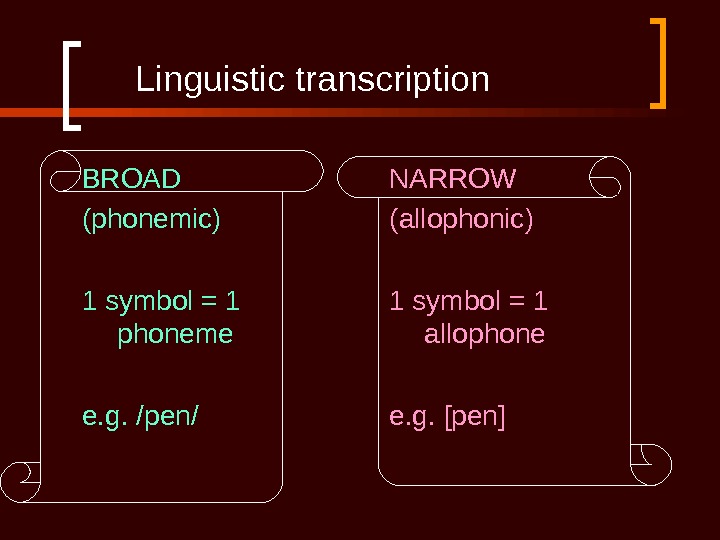

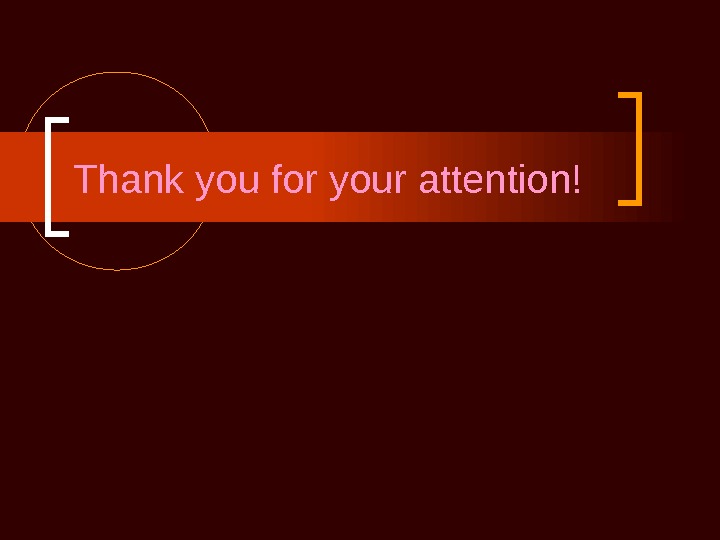
- Размер: 920.5 Кб
- Количество слайдов: 27
Описание презентации THE THEORY OF PHONETICS Lectures 1+2 By Elena по слайдам
 THE THEORY OF PHONETICS Lectures 1+2 By Elena A. Filimonova
THE THEORY OF PHONETICS Lectures 1+2 By Elena A. Filimonova
 COURSE REQUIREMENTS Attendance Participation Home assignment Project Reports for seminars Continuous assessment + final exam
COURSE REQUIREMENTS Attendance Participation Home assignment Project Reports for seminars Continuous assessment + final exam
 What is GOOD PRONUNCIATION? Ways to acquire good pronunciation : 1) Ear training 2) Imitation 3) Overcoming of the native tongue interference 4) Memory work 5) Theoretical knowledge Is it possible to acquire native-speaker-like pronunciation?
What is GOOD PRONUNCIATION? Ways to acquire good pronunciation : 1) Ear training 2) Imitation 3) Overcoming of the native tongue interference 4) Memory work 5) Theoretical knowledge Is it possible to acquire native-speaker-like pronunciation?
 What science is PHONETICS? What does it study? Phonetics as a science is concerned with the human noises by which the thought is actualized in audible shape: the nature of these noises, their combinations, and their functions in relation to the meaning Phonetics studies the sound system of the language word stress syllabic structure and intonation expression level + content level
What science is PHONETICS? What does it study? Phonetics as a science is concerned with the human noises by which the thought is actualized in audible shape: the nature of these noises, their combinations, and their functions in relation to the meaning Phonetics studies the sound system of the language word stress syllabic structure and intonation expression level + content level
 METHODS OF INVESTIGATION 1. The direct observation method : by ear by sight by muscular sensation 2. The linguistic method (to determine in what way all phonetic features are used in a language to convey a certain meaning) 3. The experimental method (use of special apparatus or instruments) the laryngoscope, the artificial palate, the kymograph, the magnetic tape recorder, the oscillograph, the spectrograph, X-ray photography, slow motion films, speech synthesizers
METHODS OF INVESTIGATION 1. The direct observation method : by ear by sight by muscular sensation 2. The linguistic method (to determine in what way all phonetic features are used in a language to convey a certain meaning) 3. The experimental method (use of special apparatus or instruments) the laryngoscope, the artificial palate, the kymograph, the magnetic tape recorder, the oscillograph, the spectrograph, X-ray photography, slow motion films, speech synthesizers
 Branches of Phonetics: — Sociophonetics — Psychophonetics — Russian phonetics — Theoretical phonetics — Practical/ applied phoneticssupraseg mental / segmental Phonetics. Experimental/comparative Special /general Articulatory/ Acoustic/ Auditory Descriptive/ historical phonology
Branches of Phonetics: — Sociophonetics — Psychophonetics — Russian phonetics — Theoretical phonetics — Practical/ applied phoneticssupraseg mental / segmental Phonetics. Experimental/comparative Special /general Articulatory/ Acoustic/ Auditory Descriptive/ historical phonology
 PHONETICS VS. PHONOLOGY Nikolay Sergeevich Trybetskoy Phonetics is a biological science, and is concerned with the physical and physiological characteristics of speech sounds. Phonology is a linguistic science, and is concerned with the social functions of different phonetic phenomena. Phonology is a convenient term to indicate that section of phonetics in which the social functions of speech sounds are discussed.
PHONETICS VS. PHONOLOGY Nikolay Sergeevich Trybetskoy Phonetics is a biological science, and is concerned with the physical and physiological characteristics of speech sounds. Phonology is a linguistic science, and is concerned with the social functions of different phonetic phenomena. Phonology is a convenient term to indicate that section of phonetics in which the social functions of speech sounds are discussed.
 PHONETICS and other sciences PHONETICS PHONOLOGY STATISTICS MATHEMATICS COMMUNICATION THEORY ACOUSTIC PHONETICS PHYSICS CYBERNETICSLOGICS GRAMMAR LEXICOLOGY MATHEMATICS PHYSIOLOGICAL PHONETICS PHYSIOLOGY ANATOMY ANTHROPOLOGYHISTORICAL PHONETICS HISTORY ARCHEOLOGY
PHONETICS and other sciences PHONETICS PHONOLOGY STATISTICS MATHEMATICS COMMUNICATION THEORY ACOUSTIC PHONETICS PHYSICS CYBERNETICSLOGICS GRAMMAR LEXICOLOGY MATHEMATICS PHYSIOLOGICAL PHONETICS PHYSIOLOGY ANATOMY ANTHROPOLOGYHISTORICAL PHONETICS HISTORY ARCHEOLOGY
 Practical application of phonetics teaching correct pronunciation and eliminating dialect features from the pronunciation; logopedics and curing speech defects; teaching normal oral speech to deaf & dumb people; devise alphabets for unwritten languages & spelling reforms; technical acoustic & sound technology; information & communication, cybernetics.
Practical application of phonetics teaching correct pronunciation and eliminating dialect features from the pronunciation; logopedics and curing speech defects; teaching normal oral speech to deaf & dumb people; devise alphabets for unwritten languages & spelling reforms; technical acoustic & sound technology; information & communication, cybernetics.
 SPEECH SOUNDS and their aspects Speech sounds are of a complex nature and have three different aspects: 1. ACOUSTIC SPEECH SOUNDS = sound waves. They are characterized by musical tone/ pitch, intonation, voice timber, intensity, stress/ accent, duration/ length. 2. BIOLOGICAL SPEECH SOUNDS = phenomena resulting from the activities of the speech organs (anthropophonics). 3. LINGUISTIC SPEECH SOUNDS = articulatory, acoustic, auditory and functional phenomena
SPEECH SOUNDS and their aspects Speech sounds are of a complex nature and have three different aspects: 1. ACOUSTIC SPEECH SOUNDS = sound waves. They are characterized by musical tone/ pitch, intonation, voice timber, intensity, stress/ accent, duration/ length. 2. BIOLOGICAL SPEECH SOUNDS = phenomena resulting from the activities of the speech organs (anthropophonics). 3. LINGUISTIC SPEECH SOUNDS = articulatory, acoustic, auditory and functional phenomena
![[m, n, ŋ ]; ]; nasal (articulatory aspect) resonants (acoustic aspect) sonorant (auditory aspect) all [m, n, ŋ ]; ]; nasal (articulatory aspect) resonants (acoustic aspect) sonorant (auditory aspect) all](/docs//the_theory_of_phonetics1_images/the_theory_of_phonetics1_10.jpg) [m, n, ŋ ]; ]; nasal (articulatory aspect) resonants (acoustic aspect) sonorant (auditory aspect) all these sounds are realizations of different phonemes in English, while [ŋ] is an allophone of the phoneme [n] in Italian (functional or linguistic aspect)
[m, n, ŋ ]; ]; nasal (articulatory aspect) resonants (acoustic aspect) sonorant (auditory aspect) all these sounds are realizations of different phonemes in English, while [ŋ] is an allophone of the phoneme [n] in Italian (functional or linguistic aspect)
 Functions of speech sounds: 1. constitutive – they constitute the material forms of mophemes, words & sentences; 2. distinctive – they differentiate mophemes, words & sentences (e. g. zero-oppositions; miminal pair ). 3. recognitive – the use of the right allophones in the right places facilitates normal recognition, and, consequently, understanding, of speech.
Functions of speech sounds: 1. constitutive – they constitute the material forms of mophemes, words & sentences; 2. distinctive – they differentiate mophemes, words & sentences (e. g. zero-oppositions; miminal pair ). 3. recognitive – the use of the right allophones in the right places facilitates normal recognition, and, consequently, understanding, of speech.
 THE PROBLEM OF THE PHONEME L. V. Shcherba : the phoneme may be viewed as a functional, material and abstract unit. V. A. Vassilyev: the phoneme is the smallest (i. e. further indivisible into smaller consecutive segments) language unit (sound type) that exists in the speech of all the members of a given language community as such speech sounds which are capable of distinguishing one word of the same language or one grammatical form of a word from another grammatical form of the same word».
THE PROBLEM OF THE PHONEME L. V. Shcherba : the phoneme may be viewed as a functional, material and abstract unit. V. A. Vassilyev: the phoneme is the smallest (i. e. further indivisible into smaller consecutive segments) language unit (sound type) that exists in the speech of all the members of a given language community as such speech sounds which are capable of distinguishing one word of the same language or one grammatical form of a word from another grammatical form of the same word».
 Concise working definition (by V. A. Vassilyev) “ The phoneme is a minimal abstract linguistic unit realized in speech in the form of speech sounds opposable to other phonemes of the same language to distinguish the meaning of morphemes and words. ”
Concise working definition (by V. A. Vassilyev) “ The phoneme is a minimal abstract linguistic unit realized in speech in the form of speech sounds opposable to other phonemes of the same language to distinguish the meaning of morphemes and words. ”
 ASPECTS OF THE PHONEME Abstract/ generalized/ objective Material/concrete/subjective functional
ASPECTS OF THE PHONEME Abstract/ generalized/ objective Material/concrete/subjective functional
 PHONEME, SPEECH SOUND, ALLOPHONE Allophone. Phoneme. Speech sound
PHONEME, SPEECH SOUND, ALLOPHONE Allophone. Phoneme. Speech sound
![Classification of allophones Allophones Principle [ Ө ] Subsidiary [ Ө ınk] Positional [eıt Ө ] Classification of allophones Allophones Principle [ Ө ] Subsidiary [ Ө ınk] Positional [eıt Ө ]](/docs//the_theory_of_phonetics1_images/the_theory_of_phonetics1_16.jpg) Classification of allophones Allophones Principle [ Ө ] Subsidiary [ Ө ınk] Positional [eıt Ө ] Combinatory [beł]
Classification of allophones Allophones Principle [ Ө ] Subsidiary [ Ө ınk] Positional [eıt Ө ] Combinatory [beł]
 FUNCTIONS OF THE PHONEME Are the functions of the phoneme related to the functions of the speech sounds? 1) Constitutive (e. g. think) 2) Distinctive (e. g. think-thing) 3) Recognitive (e. g. [tınk])
FUNCTIONS OF THE PHONEME Are the functions of the phoneme related to the functions of the speech sounds? 1) Constitutive (e. g. think) 2) Distinctive (e. g. think-thing) 3) Recognitive (e. g. [tınk])
 MAIN TRENDS IN THE PHONEME THEORY 1) Mentalistic/ psychological 2) Functional 3) Abstract 4) Physical 5) Cybernetic
MAIN TRENDS IN THE PHONEME THEORY 1) Mentalistic/ psychological 2) Functional 3) Abstract 4) Physical 5) Cybernetic
 MENTALISTIC/ PSYCHOLOGICAL VIEW GENERAL IDEA — The phoneme = «mental image», or psychical image of a sound. — Allophones of the phoneme are varying materializations of it. — There ’ s a discrepancy between an intended sound and the one actually pronounced. REPRESENTATIVES I. A. Baudauin de Courtenay, E. D. Sapir, Alf. Sommerfelt ( phonemes = «models which speakers seek to reproduce “ ), N. S. Trubetskoy ’ s ( phoneme = sound image/ the intention to pronounce a sound but later phoneme = a language, not psychological unit). CRITICISM It is definitely not possible to establish such ideal sounds which do not exist in reality (Bloomfield and his followers, D. Jones) PHONEME ASPECT? — ABSTRACT
MENTALISTIC/ PSYCHOLOGICAL VIEW GENERAL IDEA — The phoneme = «mental image», or psychical image of a sound. — Allophones of the phoneme are varying materializations of it. — There ’ s a discrepancy between an intended sound and the one actually pronounced. REPRESENTATIVES I. A. Baudauin de Courtenay, E. D. Sapir, Alf. Sommerfelt ( phonemes = «models which speakers seek to reproduce “ ), N. S. Trubetskoy ’ s ( phoneme = sound image/ the intention to pronounce a sound but later phoneme = a language, not psychological unit). CRITICISM It is definitely not possible to establish such ideal sounds which do not exist in reality (Bloomfield and his followers, D. Jones) PHONEME ASPECT? — ABSTRACT
 FUNCTIONAL VIEW GENERAL IDEA: — The phoneme = the minimal sound unit by which meanings may be differentiated without much regard to actually pronounced speech sounds. — Distinctive features of the sound make up the phoneme corresponding to it ( ladder: lenisness distinctive only in the third sound [d], otherwise latter). — Non-distinctive features are extracted from the phonemes thus divorcing the phoneme from actually pronounced speech sounds. REPRESENTATIVES: N. Trubetskoy, L. Bloomfield, R. Jakobson, M. Halle. PHONEME ASPECT? FUNCTIONAL
FUNCTIONAL VIEW GENERAL IDEA: — The phoneme = the minimal sound unit by which meanings may be differentiated without much regard to actually pronounced speech sounds. — Distinctive features of the sound make up the phoneme corresponding to it ( ladder: lenisness distinctive only in the third sound [d], otherwise latter). — Non-distinctive features are extracted from the phonemes thus divorcing the phoneme from actually pronounced speech sounds. REPRESENTATIVES: N. Trubetskoy, L. Bloomfield, R. Jakobson, M. Halle. PHONEME ASPECT? FUNCTIONAL
 ABSTRACT VIEW GENERAL IDEA — A stronger form of the «functional» approach. — Phonemes = essentially independent of the acoustic and physiological properties associated with them, that is of speech sounds. — Phonemes = conceptions existing in the mind but not in human speech, speech sounds being only phonetic manifestations of these conceptions. REPRESENTATIVES F. de Saussure, L. Hjelmslev and his associates in the Copenhagen Linguistic Circle, H. J. Uldall and K. Togby. PHONEME ASPECT? ABSTRACT AND FUNCTIONAL
ABSTRACT VIEW GENERAL IDEA — A stronger form of the «functional» approach. — Phonemes = essentially independent of the acoustic and physiological properties associated with them, that is of speech sounds. — Phonemes = conceptions existing in the mind but not in human speech, speech sounds being only phonetic manifestations of these conceptions. REPRESENTATIVES F. de Saussure, L. Hjelmslev and his associates in the Copenhagen Linguistic Circle, H. J. Uldall and K. Togby. PHONEME ASPECT? ABSTRACT AND FUNCTIONAL
 PHYSICAL VIEW GENERAL IDEA — The phoneme = a «family» of related sounds satisfying certain conditions: a) The various members of the «family» must show phonetic similarity to one another; b) No member of the «family» may occur in the same phonetic context as any other. — The phoneme = a group of articulatorily similar sounds without any regard to its functional and abstract aspects. CRITICISM it is not easy to see how sounds could be assigned to the same phoneme on any other grounds than differentiating between words? REPRESENTATIVES D. Jones, B. Bloch and G. Trager PHONEME ASPECT? MATERIAL
PHYSICAL VIEW GENERAL IDEA — The phoneme = a «family» of related sounds satisfying certain conditions: a) The various members of the «family» must show phonetic similarity to one another; b) No member of the «family» may occur in the same phonetic context as any other. — The phoneme = a group of articulatorily similar sounds without any regard to its functional and abstract aspects. CRITICISM it is not easy to see how sounds could be assigned to the same phoneme on any other grounds than differentiating between words? REPRESENTATIVES D. Jones, B. Bloch and G. Trager PHONEME ASPECT? MATERIAL
 CYBERNETIC VIEW GENERAL IDEA — The phoneme cannot be perceived by means of direct observation; therefore it is a construct. — Subject of the «two-level theory of phonology “ : theoretical phonology («the study of the nature of phonological reality “ ), and general phonology («typology of concrete phonological systems “ ), — The «construct» requires a special conceptual apparatus in order to be cognized. CRITICISM — Phonemes can be perceived and are daily perceived by members of the same linguistic communities (alphabets). — Separate phonemes can be recognized (the Cockney dialect: [aı] instead of [eı], shift the [h]-phoneme in initial positions of words: [iz], [еэ] for his, hair, and [hea] for air). REPRESENTATIVES S. K. Showmyan. PHONEME ASPECT? ABSTRACT
CYBERNETIC VIEW GENERAL IDEA — The phoneme cannot be perceived by means of direct observation; therefore it is a construct. — Subject of the «two-level theory of phonology “ : theoretical phonology («the study of the nature of phonological reality “ ), and general phonology («typology of concrete phonological systems “ ), — The «construct» requires a special conceptual apparatus in order to be cognized. CRITICISM — Phonemes can be perceived and are daily perceived by members of the same linguistic communities (alphabets). — Separate phonemes can be recognized (the Cockney dialect: [aı] instead of [eı], shift the [h]-phoneme in initial positions of words: [iz], [еэ] for his, hair, and [hea] for air). REPRESENTATIVES S. K. Showmyan. PHONEME ASPECT? ABSTRACT
 Linguistic transcription BROAD (phonemic) 1 symbol = 1 phoneme e. g. /pen/ NARROW (allophonic) 1 symbol = 1 allophone e. g. [pen]
Linguistic transcription BROAD (phonemic) 1 symbol = 1 phoneme e. g. /pen/ NARROW (allophonic) 1 symbol = 1 allophone e. g. [pen]
 Test on the lecture 1) What is a phoneme? 2) Name a phoneme! 3) What approach to the phoneme do you share? 4) How many phonemes are there in English? 5) Spell and transcribe in English the proper name Хрущев. How many phonemes and morphemes did you use? 6) Who is this man?
Test on the lecture 1) What is a phoneme? 2) Name a phoneme! 3) What approach to the phoneme do you share? 4) How many phonemes are there in English? 5) Spell and transcribe in English the proper name Хрущев. How many phonemes and morphemes did you use? 6) Who is this man?
 Thank you for your attention!
Thank you for your attention!

